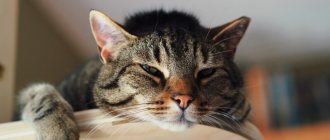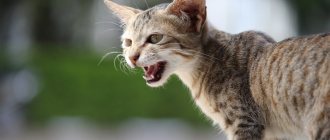The domestic cat differs from the wild one in having a more docile character. He easily makes contact with people and gladly allows himself to be taken care of. But sometimes it still shows a certain wildness in its behavior, which is expressed in the fact that the cat growls and hisses at the members of the family in which it lives. And if at first this behavior even slightly amuses some owners, then with regular and frequent manifestation of aggression in this way, any owner begins to think about its causes and possible consequences. Especially if there is a small child in the family.
Fear as a reason for growling
Hissing and growling associated with fear appears due to insufficient attention to the kitten. If the kitten rarely had contact with people, did not receive proper attention from them, or even suffered insults or even beatings from them, then fear of people will accompany an already adult cat. To understand that it was fear that caused the growling, pay attention to the following factors:
- a cat can rush at its owners in the presence of a certain stimulus, real or imaginary;
- if a pet is “cornered”, it hisses and growls much more intensely;
- aggression is accompanied by appropriate warning postures;
- the pet can connect its paw swings to the growl;
- when the situation comes to its logical end, the animal begins to relieve stress, for example, by licking the fur.
You cannot punish a cat for such behavior, since with such tactics it will always expect bad things from a person.
Leadership in the cat family
When kittens switch to adult food and learn to defend themselves, they become independent and enter adulthood.
During this period, they cease to be cat children and become competitors for the attention of their owners, for the best tidbit, for territory. Hierarchy is very important in cats
When kittens switch to adult food, they become independent and enter adulthood.
By hissing, biting, and persecuting, the older cat asserts its dominance, the right to territory and the care of its owners.
At this age, it’s time to separate the cat and kittens and find a new home for the kittens. In special cases, you can try to endure and let them figure out for themselves who will be at what social level and themselves obey the subsequent rules established by the animals.
Frustration
Frustration is a state in which a pet's needs are not met. Scientists believe that this disorder occurs if the kitten is not weaned off cat milk naturally.
As a result, the cat is not able to get its own food. He expects some kind of reward and growls if he doesn't get it. How to recognize this reason:
- the cat hisses at the owner, even if he trusts him;
- the pet growls if in any situation he did not get the desired reward;
- the cat did not receive mother's milk;
- The cat screams loudly and rushes around the door.
This also manifests itself when the owner does not serve food quickly enough, opens the front door, or simply moves away from the pet.
How to calm a cat
You can calm a cat that is actively aggressive towards you in the following ways so that it does not cause you harm:
- put on protective clothing and take the animal in your arms, quickly wrap it in a blanket;
- Always have a water spray with you so that in case of aggressive behavior you can spray a little water in the direction of the animal. This way you will protect yourself from possible consequences;
- Do not tease or provoke the animal if you see impending aggression or after the first attack attempt.
Also, to curb the harsh behavior of the animal, the following actions should be taken:
step away from the cat, you may need to leave the room for at least 10 minutes so that he “burns out”; if the cause of aggression is another cat or animal, then they should be isolated from each other for a while and introduced gradually; sit and do not look into the cat's eyes during the period of irritation, this will only increase its fear. You can lie down on the floor. This will make you appear shorter to the cat and this will calm her down; do not pay attention to the cat for a while so that he understands that you do not pose any threat to him; make hiding places for the cat - sometimes staying in a safe shelter for a while helps calm the animal’s negativity
If the cat is scared and has nowhere to run, the aggression will only intensify; approach the cat slowly and carefully, avoiding touching; or let him come to you himself, so that the cat can be convinced that you are open to communication and do not want to hurt him. Let him sniff you, rub his head, so the animal will quickly understand that you are not as scary as he thinks; feed the cat or give it water; do not resort to punishment, otherwise attacks of aggression will be more frequent.
Predator instinct
Everyone is familiar with the game when the owner plays with a kitten, moving his hand or foot under the blanket. It is at this moment that predatory behavior awakens. Only a person perceives this situation as a game, and the pet learns to hunt with all responsibility. This reason is easy to recognize:
- a cat attacks a person from an ambush;
- When you shout back at the cat, the pet begins to behave even more aggressively.
When this behavior goes too far, it becomes a problem.
INTERESTING TO LEARN: How and with what to properly and painlessly comb a cat
Leadership in the cat family
When kittens switch to adult food and learn to defend themselves, they become independent and enter adulthood.
During this period, they cease to be cat children and become competitors for the attention of their owners, for the best tidbit, for territory. Hierarchy is very important in cats
When kittens switch to adult food, they become independent and enter adulthood.
At this age, it’s time to separate the cat and kittens and find a new home for the kittens. In special cases, you can try to endure and let them figure out for themselves who will be at what social level and themselves obey the subsequent rules established by the animals.
Possessive instinct
A cat's instinct of ownership is much stronger than a human's. A pet can growl if it wants to show itself as the master of the situation. Even if the animal is the only one in the house, it is driven by this instinct at the genetic level.
To understand that it is precisely this reason that provokes the growl, just look at the circumstances under which the pet growls.
If he protects food or a favorite toy, it means that the possessive instinct has begun to play in him. What to do in this situation? First, you need to move away from the cat to a safe distance, since growling and hissing are the last warning before an attack. The cat may bite or scratch you.
Rabies
Although we mentioned in this article that the reasons for a cat attack can be fear or pain, it is worth looking at another reason for aggression: rabies.
Rabies is a fatal disease that can be transmitted from one animal to another. Once the virus reaches the brain, it begins to affect behavior. In many cases, one of the changes is increased aggressiveness.
In order to protect yourself and your animal from this pathology, do not forget about vaccinating your pets, and also do not let your purrs walk on the street, where they can be bitten by a rabid animal.
If you notice that an unvaccinated cat that has free access to the outdoors or is in contact with animals that walk outside becomes very aggressive for no apparent reason, contact your veterinarian immediately!
Being in a team
If a cat does not like to be in large crowds of people, play with children or roam from hand to hand, it is better to isolate it in the next room. Some animals simply cannot stand large companies and warn not to be touched by growling.
You should not pick up the animal, stroke it, or allow children to play with it, since the cat can also warn of an attack, and its hissing or growling can very soon turn into scratching.
Can cats growl?
For wild cats, growling is a familiar language of communication.
Many owners of exquisite cat breeds (for example, hairless cats, British) do not believe that their creature with documents and pedigree can growl like some kind of wild animal. However, time passes, and one fine day, the owners still hear this animal roar from the lips of their cute cat. It's not surprising.
Whatever breed your pet belongs to, its ancestors are wild cats, who expressed their emotions in such a primitive language of communication as growling.
As a rule, this happened in situations where the animal needed to defend territory, protect offspring or a female, and, of course, scare away uninvited guests from its prey. Then the wild cats took a threatening pose and began to growl menacingly, speaking in their own language that they were in charge here, and everyone else had better just get out of the way.
Other reasons
The cause of aggressive behavior may well be pregnancy. This is a natural phenomenon; in nature, a pregnant cat always protects her unborn kittens. Try to let the animal know that it can trust you. Soon the cat will understand this and stop behaving aggressively. Inappropriate behavior may persist after the birth of the babies, but when the pet understands that the kittens are not in danger, the aggression will disappear.
Illness can also cause nervousness and aggression. When your pet is in pain, he doesn't want to be bothered. This is why a cat may hiss or growl when you pick it up. Don’t guess what disease has afflicted your pet; take him to the vet.
To understand what role illness plays in growling and sudden hissing, take a closer look at the cat’s behavior. He may be nervous, apathetic, eat and sleep poorly, lick his fur, or try to eliminate the cause of pain with his teeth.
Also sometimes the cat’s behavior after anesthesia is inappropriate. This is normal, since the pet does not perceive the surrounding reality for some time and is simply afraid of it. Try to calm the cat down, let him know that you are nearby, speak kind words and pet him.
INTERESTING TO KNOW: How and with what to wash a cat’s eyes
Signs
Typically, a cat hisses when it is afraid of other animals or people. But traditionally it is believed that in this way she shows aggression, she can even rush and attack.
When an animal makes such sounds, it becomes tense, bends its back, tail, and may press its ears. What does a hissing cat usually look like?
- His fur instantly stops being tousled, it seems that it has turned from smooth to fluffy, voluminous. Visually, the cat even looks larger at such a moment.
- When a cat gets angry, his back arches. This pose is a signal that the animal can and will rush at the offender or someone who, in his opinion, poses a danger.
- The ears are flattened for a reason. They talk about distrust of those around them. It is also a kind of protection for the head from injury.
- An expressive look conveys all the emotions of a cat - courage, aggressiveness, determination. Meowing may also be heard along with the hissing, but it does not make the disheveled cat any cuter. On the contrary, the sounds complement the appearance and confirm the readiness to stand up for oneself and even rush at a person.
The owner of the animal, having studied its habits, will be able to figure out when a cat hisses because of a sense of danger, and when because of a feeling of aggression.
Pet injures its own tail
Sometimes it happens that a cat bites its tail, and when trying to prevent it, it begins to hiss and growl. This is dangerous because in some cases this behavior leads to further tail amputation. There may be several reasons for this disorder:
- the owners moved to a new place of residence;
- a new resident has appeared in the family;
- they began to pay less attention to the cat;
- The pet has experienced psychological trauma.
Often a cat may chew its tail at night when all family members are sleeping.
Injuries, illnesses
Your cat may look quite healthy, which does not at all exclude some diseases that are smoothed out or that arose not so long ago. Internal discomfort leads to unusual behavior, which is expressed, in particular, by unmotivated aggression.
This is interesting! If we are talking about illness, increased nervousness is often accompanied by refusal to eat/drink, apathy, frequent licking of fur and biting some parts of the body.
Tail biting
You may notice your pet trying to bite its tail and hear an angry hiss as it tries to prevent it. Sometimes the cat chews its tail at night, when everyone is lying down on the side.
The reasons for such a disorder can be various events:
- moving to a new apartment;
- birth of a baby;
- lack/decreased attention;
- other psychological trauma.
This kind of cat behavior must be stopped by getting to its source. Otherwise, the animal faces tail amputation.
Pregnancy
A cat growls and hisses when she is preparing to become a mother or immediately after giving birth to kittens, especially if a person has managed to undermine her trust. It will have to be restored, showing the pet that you will not hurt her or her offspring. As soon as the animal calms down, the aggressive attacks towards you will stop.
Anesthesia
A disruption in the cat’s usual behavior also occurs after undergoing general anesthesia . Animals have a hard time recovering from anesthesia and at this moment can behave very strangely, including hissing at their beloved owner. However, such a reaction is observed quite rarely, but no matter how the cat behaves, be there, stroke and calm it.
Return to content
How to respond to a growl
It is important to follow a list of rules that will allow you to pacify your pet and eliminate conflict:
- The cat's character is designed in such a way that you are unlikely to be able to pacify your pet right away. Wait a few minutes for the animal to calm down.
- When a certain amount of time has passed and the pet has completely calmed down, try to establish contact with him. Pet him, talk to him, give him a treat.
- If the reason is that the animal is in pain, take him to the vet immediately, as pain may indicate the severity of the disease.
It happens that a cat simply has an aggressive character, and nothing can be done about it. In this case, do not try to change your pet, but adapt to it. He loves you, he just can’t show it with affection and purring. Understand him and accept him for who he is.
Why does a cat meow when he eats?
Natural vocalization in the form of a loud and inviting meow
happens to a domestic cat when she wants to eat, asks to open the door for her, calls the kittens, meets the owner. When a cat purrs and rumbles, it means that she is calm and content, well-fed, warm and with her owner nearby.
Interesting materials:
How to convert a file from tif to pdf? How to convert a file from Word to PowerPoint? How to convert TIFF file to JPG online? How to convert a file to PDF on an iPhone? How to convert Key format to PPT? How to convert pdf format to PPTX? How to convert a photo from TIFF to JPEG? How to transfer gigabytes from Yota to Yota? How to convert Gcal to m3 heating? How to convert Gcal to MW?
How to stop an animal from growling
If growling and aggressive behavior are inherent in the character of a cat, then it is unlikely to be weaned from it. However, if the reason lies elsewhere, then it should simply be eliminated. If you cannot do this yourself, you need to seek help from a specialist.
Important: you should not shout at the cat or humiliate it, much less hit it; this may not have the effect you expect, and the pet will become even more aggressive.
Hissing at other animals
The mustachioed purr can demonstrate dissatisfaction and aggressive behavior towards its relatives, kittens or other pets.
For adult cats and female cats
All representatives of the cat family are considered loners. Even when living in the same house or apartment with people, your pet wants to feel independent.
Therefore, the cat hisses at the new cat, trying to drive the stranger out of the territory that it considers only its own. Females are more jealous of their owner and everything that surrounds her. Adult males perceive new neighbors more calmly, taking them under their protection. But other males are treated as competitors.
Aggression and manifestations of discontent are a defensive reaction that lasts until the adult individuals come to terms with living together and divide the territory in half. A person’s task is to make friends with pets with the least loss for both parties.
For kittens: ours and others'
Most often, sterilized individuals who have never given birth hiss at other people's kittens. They are afraid of strange creatures that smell of milk and another female.
A mother’s emotions towards her babies can be caused by various reasons:
Sometimes a mother drives a weakened baby away from her in a similar way, not wanting to waste milk on him. This is how the natural instinct of natural selection manifests itself. The female does not want to waste her energy on him. Mothers are also aggressive towards older children, considering them competitors.
On other pets
The perception of other animals unexpectedly appearing in the house may not be immediately positive. Screams, hissing and growling will inevitably accompany the first meeting of new neighbors. Owners with mustaches especially cannot stand dogs.
Even if the dog does not pretend to seize someone else's territory, the cat will continue to react negatively to his presence. Relations between them will improve over time, but only a person can speed up the process of reconciliation. To do this, the owner must pay enough attention to each pet, taking responsibility for raising both.
Kitten growl
The case of the little kitten requires a separate description. The baby has to learn a lot of new things about the world around him, but for now he knows nothing and experiences a lot of emotions when looking at the surrounding reality.
Watch your baby, try to show him that you are there for him, that you support him in everything. Kittens can be afraid of the unknown, while hissing, growling and fluffing their tails. They may try to show themselves capable of attack or defense in order to be taken into account.
However, establish contact with the kitten gradually; you should not immediately shower it with great attention, this can lead to stress, as a result of which mental trauma will occur, and the baby will simply become even more aggressive. This may continue in the future, for life.
Thus, the growling of an animal is a common phenomenon that many owners encounter. Understand its reasons, and the cat will thank you with affection and devotion.
Cat sounds are more varied than they seem.
Everyone knows that cats purr and meow. We learn about this in early childhood. However, the auditory signals given by a cat are much more varied and complex. The cat growls, grunts, snorts, hisses, howls.
Even a simple meow takes different forms depending on the emotions that the animal is experiencing at the moment. However, you should not think that the sounds of cats are only a reflection of the mood of our pets. They perform another important function: they serve for communication. So if you know their meaning, talking to your cat will be much easier.
Photo: Pixabay
The kitten attacks food and spoons, bites and scratches its owners, and constantly growls. Aggressive behavior.
First of all, accept the kitten’s behavior as such for now.
Please tell us in more detail what you feed your kitten and cats. Describe your diet. If food, then the brand of food. Further. If it is “not manual”, then there is no need for it yet. Don't force your communication on him. Such unsociable kittens may then begin to have a neutral attitude towards the person, or even become attached to him. Be content with what you have. He sleeps on his knees - great. Let him sleep. Doesn't want to play? Ok, there is no need to actively impose your attention on him, provoking defensive actions.
He growls and bites not out of malice. There is some irritating factor, or even several, that makes him feel anxious, literally fight off food and fight off people.
Are there children or relatives in the house who may have a negative attitude towards the kitten in your absence? This may seem absurd at first, but, alas, often the cause of the problem lies on the surface. Pay attention to the general mood in the family - perhaps even talking in a raised voice can provoke the animal to worry and panic.
Further. Genetics. The kitten is a mestizo, and what traits it inherited is also a big question. Although for me genetic factors are not decisive in pet behavior problems, it is also worth keeping in mind. Animals, like people, have their own unique characters. They are individuals. And this is worth accepting, adjusting in search of a compromise, but without breaking your personality.
Are the cats in the house neutered?
For now, take the situation in such a way that the kitten needs help and understanding. I will be glad to answer counter questions. Please don't leave the topic. Together we will choose a behavior strategy.
Source
What to do?
When kittens hiss and show aggression, as well as other unpleasant symptoms, then most likely the problem lies in the disease. In this case, you should not delay visiting the veterinarian. The specialist will order examinations, based on the results of which he will prescribe treatment. If a sleeping or awake cat is constantly restless and growls, then this may be caused by stress or fear. It is worth calming the pet, paying more attention to it, petting it. If necessary, sedative medications are prescribed.
Why does my kitten growl and fight when he eats?
Why does a cat growl? If you love cats, but don't quite understand their “language,” then you are not alone. The mysterious behavior of cats often baffles even experienced owners, but growling and hissing are certainly not signs of happiness and contentment.
Growling is often accompanied by an offensive posture in felines. When a cat acts aggressively, he is essentially trying to look like a tough guy. He threatens and wants to intimidate anyone and everyone who stands in his way. If a cat growls at its owner, this is usually a sign that the owner should “get lost.”
Hissing is not only a warning for someone - human or other animal - to leave. It can also be a prerequisite for a subsequent physical attack. If you notice that your cat is growling, then it is not surprising that he will also hit, scratch, hiss and bite. These are quite dangerous situations, so it is important not to provoke an aggressive and hissing cat. If a cat acts in an aggressive manner, then it should be left alone as quickly as possible.
If you notice that your cat is growling in a low position, almost lying on its stomach, then this is probably not a sign of aggression, or the aggression is not directed at you. In these cases, the cat may be warning you about a possible danger that it sensed in the distance. If the growling is particularly prolonged, then you should probably be on guard.
Growling is often simply a sign of fear. The cat may not be aggressive. She may simply be terrified of any situation in which she is. Growling can also indicate irritation. If your cat just isn't in the mood to play with you, she may start growling and hissing as a way of telling you that "I'm not in the mood to do this right now." Meowing and growling may not contain any signs of aggression at all.
You need to be careful around a growling cat, especially if there are children or other animals around. This is especially important if the cat is a stray or feral. Remove children and other pets from the situation as soon as possible. If the cat tries to attack, then in any case, immediately seek medical help. Cat scratches and bites can be very dangerous and cause infections and other illnesses, so don't take any chances.
Source










